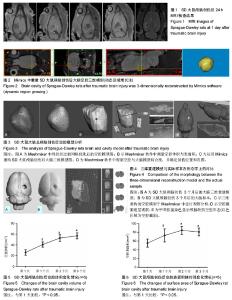| [1] Pohl KM, Bouix S, Nakamura M, et al. A hierarchical algorithm for MR brain image parcellation. IEEE Trans Med Imaging. 2007;26(9):1201-1212.
[2] Kelly ML, Roach MJ, Banerjee A, et al. Functional and long-term outcomes in severe traumatic brain injury following regionalization of a trauma system. J Trauma Acute Care Surg. 2015;79(3):372-377.
[3] Palma G, Tedeschi E, Borrelli P, et al. A Novel Multiparametric Approach to 3D Quantitative MRI of the Brain. PloS One. 2015;10(8):e0134963.
[4] Zöllner FG, Daab M, Sourbron SP, et al. An open source software for analysis of dynamic contrast enhanced magnetic resonance images: UMMPerfusion revisited. BMC Med Imaging. 2016;16:7.
[5] Chen X, Egger J. Development of an open source software module for enhanced visualization during MR-guided interstitial gynecologic brachytherapy. Springer Plus. 2014;3:167.
[6] 陈以胜,王景景,陈旭义,等. 3D打印技术制备大鼠脊髓仿生支架的研究[J].中国修复重建外科杂志, 2015,29(3): 364-367
[7] Simons CJ, Cobb L, Davidson BS. A fast, accurate, and reliable reconstruction method of the lumbar spine vertebrae using positional MRI. Ann Biomed Eng. 2014; 42(4):833-842.
[8] Rubenstein R, Chang B, Davies P, et al.A novel, ultrasensitive assay for tau: potential for assessing traumatic brain injury in tissues and biofluids. J Neurotrauma. 2015;32(5):342-352.
[9] Peng W, Xing Z, Yang J, et al. The efficacy of erythropoietin in treating experimental traumatic brain injury: a systematic review of controlled trials in animal models. J Neurosurg. 2014;121(3):653-664.
[10] Johnstone VP, Wright DK, Wong K, et al. Experimental Traumatic Brain Injury Results in Long-Term Recovery of Functional Responsiveness in Sensory Cortex but Persisting Structural Changes and Sensorimotor, Cognitive, and Emotional Deficits. J Neurotrauma. 2015;32(17):1333-1346.
[11] 樊继宏.Mimics建模到Marc有限元分析的系统工程和实例[D].南方医科大学,2010.
[12] Schmidt R, Ratto M. Design-to-fabricate: maker hardware requires maker software. IEEE Comput Graph Appl. 2013;33(6):26-34.
[13] Budde MD, Shah A, McCrea M, et al. Primary blast traumatic brain injury in the rat: relating diffusion tensor imaging and behavior. Front Neurol. 2013;4:154.
[14] Guan J, Zhu Z, Zhao RC, et al.Transplantation of human mesenchymal stem cells loaded on collagen scaffolds for the treatment of traumatic brain injury in rats. Biomaterials. 2013;34(24):5937-5946.
[15] Ricciardi MC, Bokkers R, Butman J, et al. Trauma specific brain abnormalities in suspected mild TBI patients identified in the first 48 hours after injury: a blinded MRI comparative study including suspected acute minor stroke patients. J Neurotrauma. 2016. [Epub ahead of print]
[16] Bruns J, Hauser WA. The epidemiology of traumatic brain injury: a review. Epilepsia. 2003;44 (Suppl.10): 2-10.
[17] Brown AW, Leibson CL, Malec JF et al. Long-term survival after traumatic brain injury: a population-based analysis. Neuro Rehabilitation. 2004; 19: 37-43.
[18] Gómez PA, Castaño-Leon AM, de-la-Cruz J, et al. Trends in epidemiological and clinical characteristics in severe traumatic brain injury: Analysis of the past 25 years of a single centre data base. Neurocirugia (Astur). 2014;25(5):199-210.
[19] Marklund N, Hillered L. Animal modelling of traumatic brain injury in preclinical drug development: where do we go from here? Br J Pharmacol. 2011;164:1207-1229.
[20] Zhou Y, Lui YW. Changes in brain organization after TBI: evidence from functional MRI findings. Neurology. 2013;80(20):1822-1823.
[21] Hart T, Novack TA, Temkin N, et al. Duration of Posttraumatic Amnesia Predicts Neuropsychological and Global Outcome in Complicated Mild Traumatic Brain Injury. J Head Trauma Rehabil. 2015.[Epub ahead of print]
[22] Hiekkanen H, Kurki T, Brandstack N, et al. Association of injury severity, MRI-results and ApoE genotype with 1-year outcome in mainly mild TBI: a preliminary study. Brain Inj. 2009;23(5):396-402.
[23] Wang S, Chopp M, Nazem-Zadeh MR, et al. Comparison of neurite density measured by MRI and histology after TBI. PLoS One. 2013;8(5):e63511.
[24] Mollayeva T, Pratt B, Mollayeva S, et al. The relationship between insomnia and disability in workers with mild traumatic brain injury/concussion: Insomnia and disability in chronic mild traumatic brain injury. Sleep Med. 2015.pii: S1389-9457(15)01987-5.
[25] Bramlett HM, Dietrich WD. Long-Term Consequences of Traumatic Brain Injury:Current Status of Potential Mechanisms of Injury and Neurological Outcomes. J Neurotrauma. 2015;32(23):1834-1848.
[26] 张竞文. 弥散张量成像及磁敏感加权成像对创伤性脑损伤的实验与临床动态研究[D].天津医科大学,2011.
[27] Tsuda S, Hou J, Nelson RL, et al.,Prolonged hippocampal cell death following closed-head traumatic brain injury in rats. Neuroreport. 2016. [Epub ahead of print]
[28] Emery CA, Barlow KM, Brooks BL, et al. A Systematic Review of Psychiatric, Psychological, and Behavioural Outcomes following Mild Traumatic Brain Injury in Children and Adolescents. Can J Psychiatry. 2016; 61(5): 259-269.
[29] Grandhi R, Bonfield CM, Newman WC, et al. Surgical management of traumatic brain injury: a review of guidelines, pathophysiology, neurophysiology, outcomes, and controversies. J Neurosurg Sci. 2014; 58(4):249-259.
[30] Bahar S, Bolat D, Dayan MO, et al. Two- and three-dimensional anatomy of paranasal sinuses in Arabian foals. J Vet Med Sci. 2014;76(1):37-44.
[31] Wang J, Lui Z, Qian Z, et al.Soft tissue artifact evaluation of the cervical spine in motion patterns of flexion and lateral bending: a preliminary study. Peer J. 2016;4:e1893.
[32] Su XY, Zhao JX, Zhao Z, et al. Three-Dimensional Analysis of the Characteristics of the Femoral Canal Isthmus: An Anatomical Study. Bio Med Res Int. 2015, [Epub ahead of print].
[33] 步国强,毛仲轩.Mimics 软件模拟置钉在腰椎关节突重度退变椎弓根螺钉内固定中的应用[J].中国组织工程研究, 2015,19(17):2745-2751.
[34] Tan PY, Chen JH, Li P, et al. Improving Threshold Segmentation in 3D Reconstruction of Mandible CT Image. Sichuan da xue xue bao Yi xue ban Journal of Sichuan University. Med Sci. 2015;46(3):458-462.
[35] 邱锋,马向阳,杨进城. 应用Mimics测量脊髓容积[J]. 中国脊柱脊髓杂志, 2013,23(11):1043-1045.
[36] Schmidt R, Ratto• M. Design-to-fabricate: maker hardware requires maker software. IEEE Comput Graph Appl. 2013;33(6):26-34.
[37] Li Z, Zou D, Zhang J, et al. Use of 3D reconstruction of emergency and postoperative craniocerebral CT images to explore craniocerebral trauma mechanism. Forensic Sci Int. 2015;255:106-111.
[38] Tejszerska D, Wolanski W, Larysz D, et al. Morphological analysis of the skull shape in craniosynostosis. Acta Bioeng Biomech. 2011;13(1):35-40.
[39] Wu ZF, Lei YH, Li WJ, et al. Construction and validation of a three-dimensional finite element model of cranio-maxillary complex with sutures in unilateral cleft lip and palate patient. Shanghai kou qiang yi xue. 2013;22(1):35-40.
[40] Qin Z, Compton BG, Lewis JA, et al. Structural optimization of 3D-printed synthetic spider webs for high strength. Nat Commun. 2015;6:7038. |

